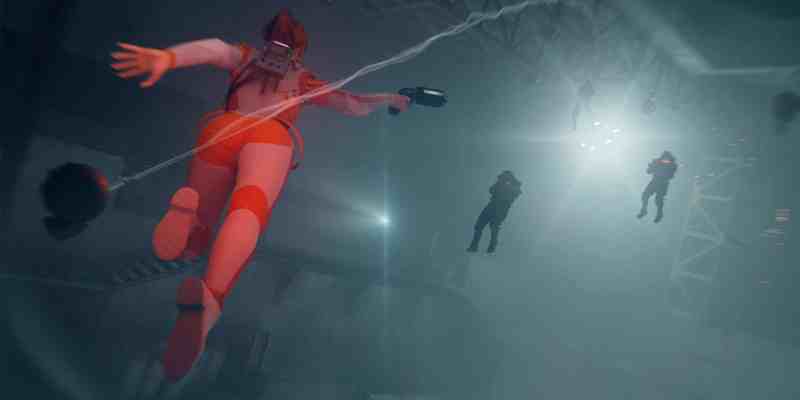This article contains some spoilers for Control: AWE and Alan Wake from Remedy Entertainment.
Remedy Entertainment has never been one to shy away from tackling the ambitious. Max Payne helped introduce the post-Matrix era of bullet time to video games. Alan Wake and Quantum Break brought in heavy inspiration and elements of literature and episodic television and married them with the interactivity of games. And the wildly impressive technology fueling 2019’s Control makes it feel like a “next-gen” game that happened to hatch a few years early.
But perhaps the most ambitious work in the developer’s history comes now, with the release of the Control: AWE expansion DLC and the first full foray into what Remedy is calling its Connected Universe. Though the core Control game contained many nods, references, and teases to Alan Wake, this brief campaign goes all in on the events, characters, and mythology of Bright Falls, Washington. The powerful result is that the true horror from the Alan Wake games seeps into Control, and it adds another new dynamic element to the infinite possibilities of the Oldest House.
Although, in the beginning, Control’s final DLC is mostly more of the same, and that’s certainly not a bad thing. The Oldest House is still a marvel to explore, with the new Investigations Sector adding another area filled with brutalist architecture, abandoned ‘70s-era technology, and a creepy sense that you’ve stumbled on a place where something very bad happened long ago.
Being able to pick up as my Jesse that I’d used to play through the entire campaign as well as the Foundation DLC was refreshing, as I had nearly every ability unlocked and fully upgraded. However, an outstanding addition to AWE is a skill that allows you to grab up to three elements of the environment telekinetically before launching them at an enemy. Not only did this make one of the standout abilities of the game even more destructively fun, but it came in handy during fights against any number of quick enemies that had a tendency to dodge the first thing hurled at them, because they definitely weren’t dodging the next two things. Ripping chunks of concrete out of the wall, blasting them at an enemy, and watching them explode into a mess of rubble remains one of the most satisfying mechanics of this entire console generation.
The main goal of the DLC is to track down Dr. Emil Hartman across the Investigations Sector. Those of you who played Alan Wake will remember Hartman as one of the main antagonists of the original game. He was a psychiatrist and author of The Creator’s Dilemma, a book that was ultimately the crux for why Alan and his wife Alice traveled to Bright Falls in the first place. He tapped into the powers of Cauldron Lake by using his treatment as a disguise for influencing artists to mold the world as he saw fit. While his actions made him a monster on the inside, he was just a man on the outside.
However, the Hartman we meet in Control is much different than the one we left behind in Alan Wake. Through the ample documents, audio logs, and various other bits of multimedia scattered about, we can piece together what happened in-between the two games that eventually led to Hartman transforming into a grotesque monstrosity that looks more like the Slender Man with elk horns than an actual human. And it’s the encounters with him that act as the most exciting moments of AWE.

Hartman feeds off the dark corners of the Oldest House, while the darkness saps away at your own mental abilities. He can teleport through the darkness, and if you find yourself in a room with him and aren’t in the safety of a light source, he’ll grab you for an instant kill. Entering a new area and not knowing whether or not Hartman would be around delivered the same survival horror endorphin rush of stumbling across Mr. X in Resident Evil 2.
The general flow of these encounters is that the lights go out at the start, save for one or two small safe areas. You have to race to these safe havens before Hartman grabs you and, from there, assess the rest of the environment for a way to begin illuminating more pockets. This usually involves finding the power cores that you became familiar with throughout the main campaign and using your telekinesis to slam it into a generator. There’s great tension leading up to your landing a bullseye, followed by relief when you successfully dash into a new safe area. By the end, you’ll usually find a way to finally light up the entire room and ward the beast off into the next area.
These encounters evolve throughout the DLC, adding in elements like red crystalline barriers that need to be destroyed before grabbing a power core, as well as waves of Hiss soldiers that you need to dispatch from the safety of the small pockets of light. The final confrontation against Hartman unfolds as a really satisfying boss battle that draws in everything you’ve learned throughout the adventure into a tense, challenging, and rewarding fight.

The way Control takes Alan Wake’s themes of horror and uses light sources as a key component extends beyond just the creature itself. Patches of darkness have formed throughout the area, and you’ll have to find mobile construction lights and carry them over to these barriers in order to press on. Watching the literal struggle between light and darkness takes so many of the themes from the original Alan Wake game and expertly marries them into Control’s expansive world and expressive mechanics.
As a big fan of Alan Wake on Xbox 360, it was fantastic to see these characters, lore, and themes return in the world of Control. Watching Alan himself grapple with the events as Hotline transmissions bleed into Jesse’s reality never came across forced and instead felt like these two worlds have always been one and the same. Without going into major spoilers, AWE ends on an ominous note that leaves the door wide open not only for both individual adventures, but their shared journey going forward. As the first major foray into the Remedy Connected Universe, I consider this a massive success, and I’m stoked to see what comes next.
